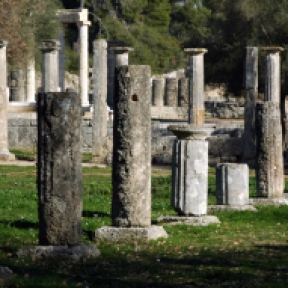As we enter week two of our 2016 Olympic Games, here’s a piece about the original Olympic Games and their home, Olympia, Greece.
The ancient games began in 776 BCE and went on every four years until they were banned as a pagan festival by the Christian Roman Emperor Theodosius in 393 CE.
The Olympian Games was one of four Panhellenic festivals held every two or four years, scheduled to alternate so that at least one or another happened each year. Besides the Olympian Games, there were the Pythian Games, the Nemean Games and the Ithsmian Games. They were all primarily religious festivals, with the Olympic Games dedicated to Zeus. They were also designed to promote friendly interaction between sometimes combatant city states. The main political entity of Ancient Greece was the city-state and conflict over resources was constant. More than competition, the games brought everyday rivals together to celebrate those things they had in common, namely religion and the great honor of being Greek.
Only free Greek men were allowed to compete in the games. Women could not compete and could only watch the games if they were unmarried. One source I read explained that the ban on married women was due to the nakedness of the athletes and, while I think that’s only speculative, there is logic to it. Whatever the reason for the ban, it was on penalty of death. It’s true that the athletes competed in the nude, which seems dangerous to me, and not very aerodynamic. Nevertheless, Ancient Greeks celebrated the fit male form and regularly put it on display. They generally exercised in the nude and had naked drinking parties called symposia.
Originally the games only lasted one day but over the years grew to five days, part of that time taken up by religious rituals. The competitive events included running, jumping, discus throwing, javelin throwing, wrestling, boxing, horse racing and chariot racing. Winners received an olive branch and red ribbons after their event and an olive wreath crown at the closing ceremony. More prizes awaited from their home towns, where they were treated as local heroes.
The site of the ancient Olympian Games was the sanctuary of Olympia on the western Peloponnese peninsula. The setting is idyllic in a lush river valley, with rolling green hills all around. The temples of Zeus and Hera were the main religious attractions. They were accompanied by treasuries and administrative buildings. A colossal ivory and gold statue of Zeus stood in his temple and was one of the Seven Wonders of the Ancient World. The main structures for athletic events were a stadium and a hippodrome for the horse and chariot races. Today, the site consists of a lot of foundations and broken columns. The most complete remains are the partially reconstructed Temple of Hera and the Philippeion, built to honor a battle victory by Philip of Macedon (father of Alexander the Great). It’s an exceptionally lovely place, do visit if you have the chance.
Olympia is about 4 hours from Athens but is best seen on a several-days tour of the Peloponnese.
Click to see tours that include Olympia on our web site.





